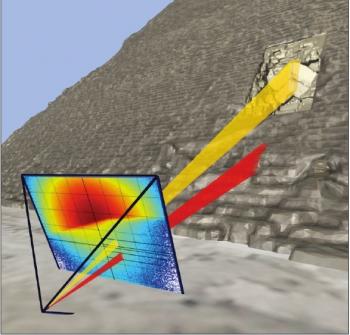
The two cones indicate the angular positions of excess muons detected from the outside with IRFU telescopes (MICROMEGAS detectors). They are due to the presence of a void in the heart of the pyramid.
The ScanPyramids collaboration has discovered a new void in the heart of the Kheops pyramid. This large vacuum was detected by muonic imaging techniques conducted by three separate teams from Nagoya University (Japan), CEC (Japan) and CEA/IRFU. It is the first discovery of a major internal structure of Kheops since the Middle Ages.
Similar in size to the Great Gallery, an architectural structure located in the heart of the Great Pyramid (47m long, 8m high), this new cavity, called ScanPyramids Big Void, has a minimum length of 30 metres. First observed with nuclear emulsion films installed in the Queen's Chamber (Nagoya University), then detected with a scintillator telescope installed in the same chamber (KEK), it was confirmed with gas detectors, MICROMEGAS, located outside the pyramid (CEA), and thus with a very different angle of view allowing to refine the location of this void. This is the first time that an instrument has detected a cavity located at the bottom of a pyramid from the outside.
These results were published by the ScanPyramids team on November 2, 2017 in the journal Nature.
• › MPGD Activities
• Institute of Research into the Fundamental Laws of the Universe • The Electronics, Detectors and Computing Division • The Nuclear Physics Division
